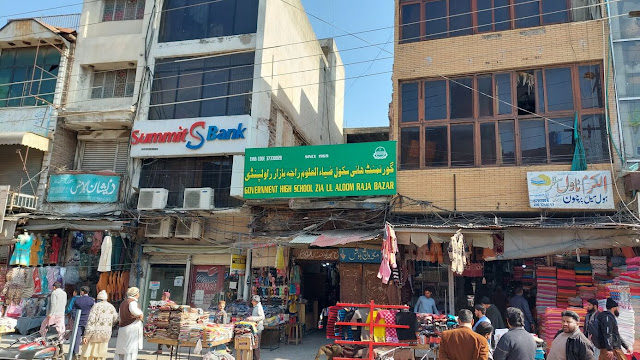Before independence and the partition of the country in 1947, Hindus formed one-third of the population of Rawalpindi city. They were an influential community and constructed beautiful houses, many of which still survive and remind us of the multi-religious society of the past and the rich cultural and architectural heritage of the pre-partition era.
Besides beautiful houses, they built many temples, one of them is the famous Kalyan Das Temple in Kohati Bazar, it is located at 33°37'19.31"N, 73° 3'47.79"E. It is a majestic building and a masterpiece of Hindu architecture.
Currently, the temple houses a special school for visually impaired children, named Government Qandeel Secondary School. The headmaster of the school was a very amiable gentleman and welcomed me warmly. However, due to some regulations, he did not permit me to take pictures, instead, he suggested to take permission from the concerned department. Which I did, a couple of days later.
The building of the temple is in the middle of the compound and presents a breathtaking view. Its lofty spirals rise to a great height and give it a majestic look. The building around the temple is a modern structure and serves as classrooms for the students.
I sat in the room of the headmaster for a while, waiting for the formalities to be cleared. During this time I had had opportunities to interact with some students and teachers, the experience was heartwarming. The courage and discipline of the students and teachers impressed me. At this moment the headmaster sahib requested me not to take pictures from inside or too closely. Soon I discovered the reason. The school building was undergoing repair and renovation work and the construction material was obstructing the view of the temple. Anyway, I avoided closer shots. However, some pictures available on the net show, beautiful paintings on the inner walls of the temple.
%20-%20Kalyan%20Das%20Temple,%20Rawalpindi.jpg)
%20-%20Kalyan%20Das%20Temple,%20Rawalpindi.jpg)
%20-%20Kalyan%20Das%20Temple,%20Rawalpindi.jpg)
%20-%20Kalyan%20Das%20Temple,%20Rawalpindi.jpg)
%20-%20Kalyan%20Das%20Temple,%20Rawalpindi.jpg)
%20-%20Kalyan%20Das%20Temple,%20Rawalpindi.jpg)
%20-%20Kalyan%20Das%20Temple,%20Rawalpindi.jpg)
%20-%20Kalyan%20Das%20Temple,%20Rawalpindi.jpg)
%20-%20Kalyan%20Das%20Temple,%20Rawalpindi.jpg)
%20-%20Kalyan%20Das%20Temple,%20Rawalpindi.jpg)
%20-%20Kalyan%20Das%20Temple,%20Rawalpindi.jpg)
%20-%20Kalyan%20Das%20Temple,%20Rawalpindi.jpg)
%20-%20Kalyan%20Das%20Temple,%20Rawalpindi.jpg)
%20-%20Kalyan%20Das%20Temple,%20Rawalpindi.jpg)
%20-%20Kalyan%20Das%20Temple,%20Rawalpindi.jpg)
%20-%20Lockhart%20Memorial,%20Rawalpindi.jpg)

%20-%20Lockhart%20Memorial,%20Rawalpindi.jpg)
%20-%20Lockhart%20Memorial,%20Rawalpindi.jpg)
%20-%20Lockhart%20Memorial,%20Rawalpindi.jpg)
%20-%20Lockhart%20Memorial,%20Rawalpindi.jpg)
%20-%20Lockhart%20Memorial,%20Rawalpindi.jpg)
%20-%20Lockhart%20Memorial,%20Rawalpindi.jpg)
%20-%20Lockhart%20Memorial,%20Rawalpindi.jpg)
%20-%20Gurdwara%20Bhai%20Mani%20Singh_resize.jpg)
%20-%20Gurdwara%20Bhai%20Mani%20Singh_resize.jpg)
%20-%20Gurdwara%20Bhai%20Mani%20Singh_resize.jpg)

%20-%20Gurdwara%20Baradari,%20Rawalpindi_resize.jpg)
%20-%20Gurdwara%20Baradari,%20Rawalpindi_resize.jpg)
%20-%20Gurdwara%20Baradari,%20Rawalpindi_resize.jpg)
%20-%20Gurdwara%20Baradari,%20Rawalpindi_resize.jpg)
%20-%20Gurdwara%20Baradari,%20Rawalpindi_resize.jpg)
%20-%20Gurdwara%20Guru%20Sri%20Nanak%20Sat%20Sang,%20Rawalpindi.jpg)
%20-%20Gurdwara%20Guru%20Sri%20Nanak%20Sat%20Sang,%20Rawalpindi.jpg)
%20-%20Gurdwara%20Guru%20Sri%20Nanak%20Sat%20Sang,%20Rawalpindi.jpg)
%20-%20Gurdwara%20Guru%20Sri%20Nanak%20Sat%20Sang,%20Rawalpindi.jpg)
%20-%20Gurdwara%20Guru%20Sri%20Nanak%20Sat%20Sang,%20Rawalpindi.jpg)
%20-%20Gurdwara%20Guru%20Sri%20Nanak%20Sat%20Sang,%20Rawalpindi.jpg)
%20-%20Gurdwara%20Guru%20Sri%20Nanak%20Sat%20Sang,%20Rawalpindi.jpg)
%20-%20Gurdwara%20Guru%20Sri%20Nanak%20Sat%20Sang,%20Rawalpindi.jpg)
%20-%20Gurdwara%20Guru%20Sri%20Nanak%20Sat%20Sang,%20Rawalpindi.jpg)



%20-%20Gurdwara%20Lalkurti,%20Rawalpindi.jpg)
%20-%20Gurdwara%20Lalkurti,%20Rawalpindi.jpg)
%20-%20Gurdwara%20Lalkurti,%20Rawalpindi.jpg)
%20-%20Gurdwara%20Lalkurti,%20Rawalpindi.jpg)

















